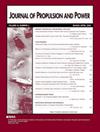可膨胀石墨添加剂提高燃烧速度和电机推力
IF 2.4
4区 工程技术
Q2 ENGINEERING, AEROSPACE
引用次数: 0
摘要
控制火箭推力可以通过推进剂燃烧速率催化剂和促进剂来实现。本文通过在粘结剂基体中添加少量可膨胀石墨(EG)来提高燃烧速度,从而提高混合动力和固体发动机的推力。EG是嵌入石墨薄片的一种形式,其在加热时将其外观改变为长度和体积显著更大的细长纤维/串。假设燃烧表面的细长EG串将热量从热环境传导到本体,从而提高燃烧速率。高速拍摄含有EG添加剂的燃料板在火焰中的表面现象,有助于在混合电机中,聚酯与端羟基聚丁二烯或石蜡燃料相比,对燃烧速率提高的影响更大(高达两倍)。对高氯酸铵-聚合物固体推进剂链燃烧的类似研究表明,与添加5%EG的聚酯粘合剂相比,端羟基聚丁二烯的表面现象不同,燃烧速率显著提高(60%及以上)。可以得出结论,EG可以作为一种新型的燃烧速率和推力增强器,而不会降低混合动力发动机(包括固体燃料冲压发动机)和固体推进剂发动机的聚合物燃料/粘合剂的机械性能。本文章由计算机程序翻译,如有差异,请以英文原文为准。
Increasing Burning Rate and Motor Thrust by Expandable Graphite Additives
Controlling rocket thrust may be done via propellant burning rate catalysts and enhancers. This paper presents an experimental investigation on increasing the thrust of hybrid and solid motors by adding a small fraction of expandable graphite (EG) within the binder matrix to enhance burning rate. EG is a form of intercalated graphite flakes that upon heating change their appearance to elongated fibers/strings of substantially larger length and volume. The elongated EG strings at the burning surface are hypothesized to conduct heat from the hot surroundings to the bulk, thereby increasing the burning rate. High-speed photography of the surface phenomena of fuel slabs containing EG additive subjected to flame supports the greater effect on burning rate enhancement (up to twofold) for polyester versus hydroxyl-terminated polybutadiene or paraffin wax fuels in hybrid motors. Similar investigation on the burning of ammonium perchlorate–polymer solid propellant strands revealed different surface phenomena and substantial burning rate increase (60% and more) for hydroxyl-terminated polybutadiene versus polyester binder with 5% EG additive. It can be concluded that EG can serve as a novel burning rate and thrust enhancer without deterioration of the mechanical properties of the polymeric fuel/binder for hybrid (including solid fuel ramjet) and solid propellant motors.
求助全文
通过发布文献求助,成功后即可免费获取论文全文。
去求助
来源期刊

Journal of Propulsion and Power
工程技术-工程:宇航
CiteScore
4.20
自引率
21.10%
发文量
97
审稿时长
6.5 months
期刊介绍:
This Journal is devoted to the advancement of the science and technology of aerospace propulsion and power through the dissemination of original archival papers contributing to advancements in airbreathing, electric, and advanced propulsion; solid and liquid rockets; fuels and propellants; power generation and conversion for aerospace vehicles; and the application of aerospace science and technology to terrestrial energy devices and systems. It is intended to provide readers of the Journal, with primary interests in propulsion and power, access to papers spanning the range from research through development to applications. Papers in these disciplines and the sciences of combustion, fluid mechanics, and solid mechanics as directly related to propulsion and power are solicited.
 求助内容:
求助内容: 应助结果提醒方式:
应助结果提醒方式:


